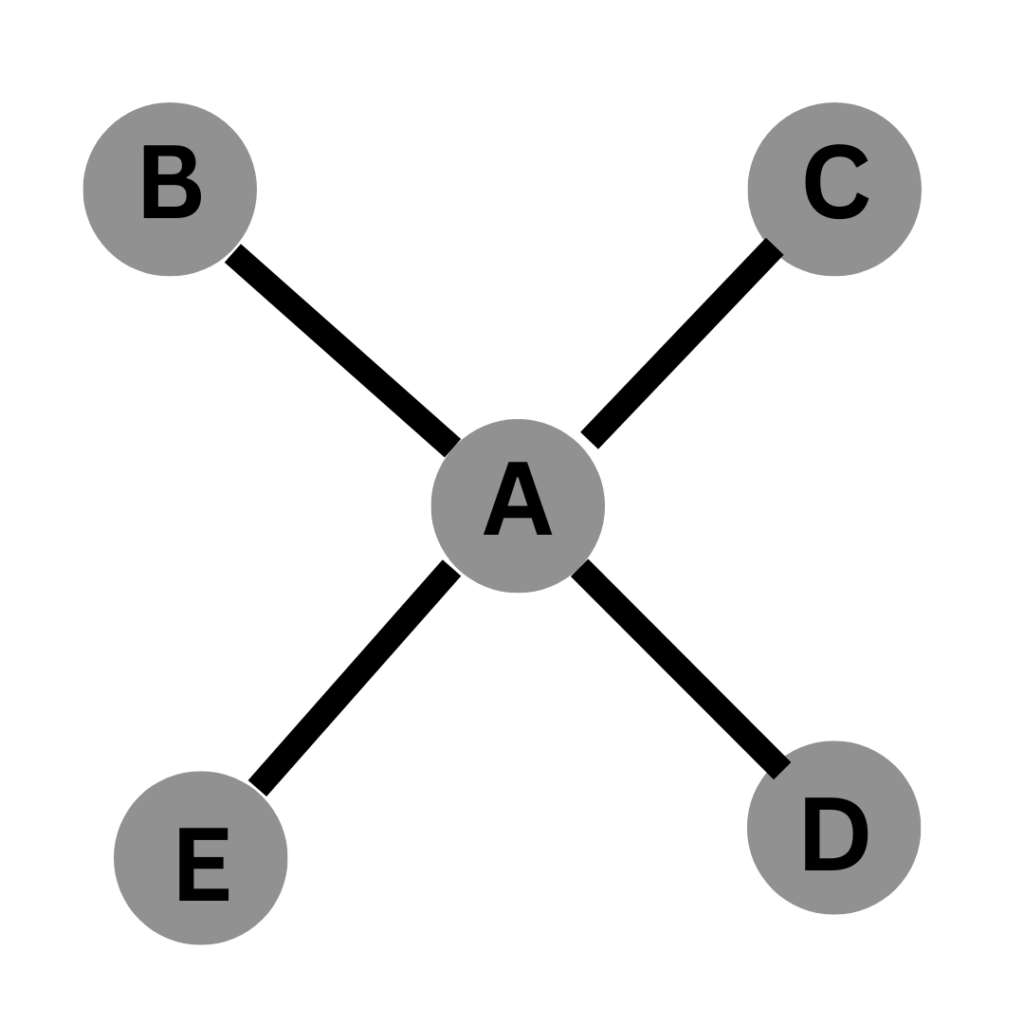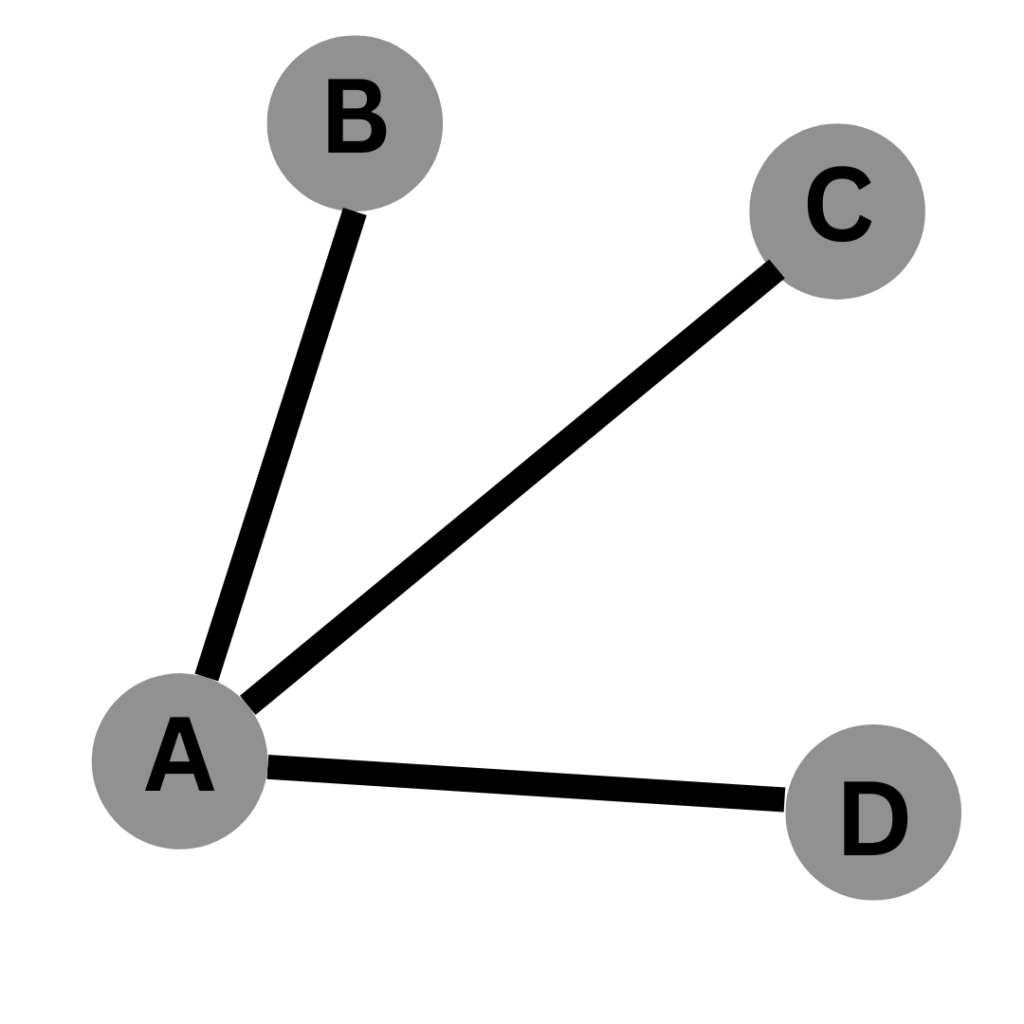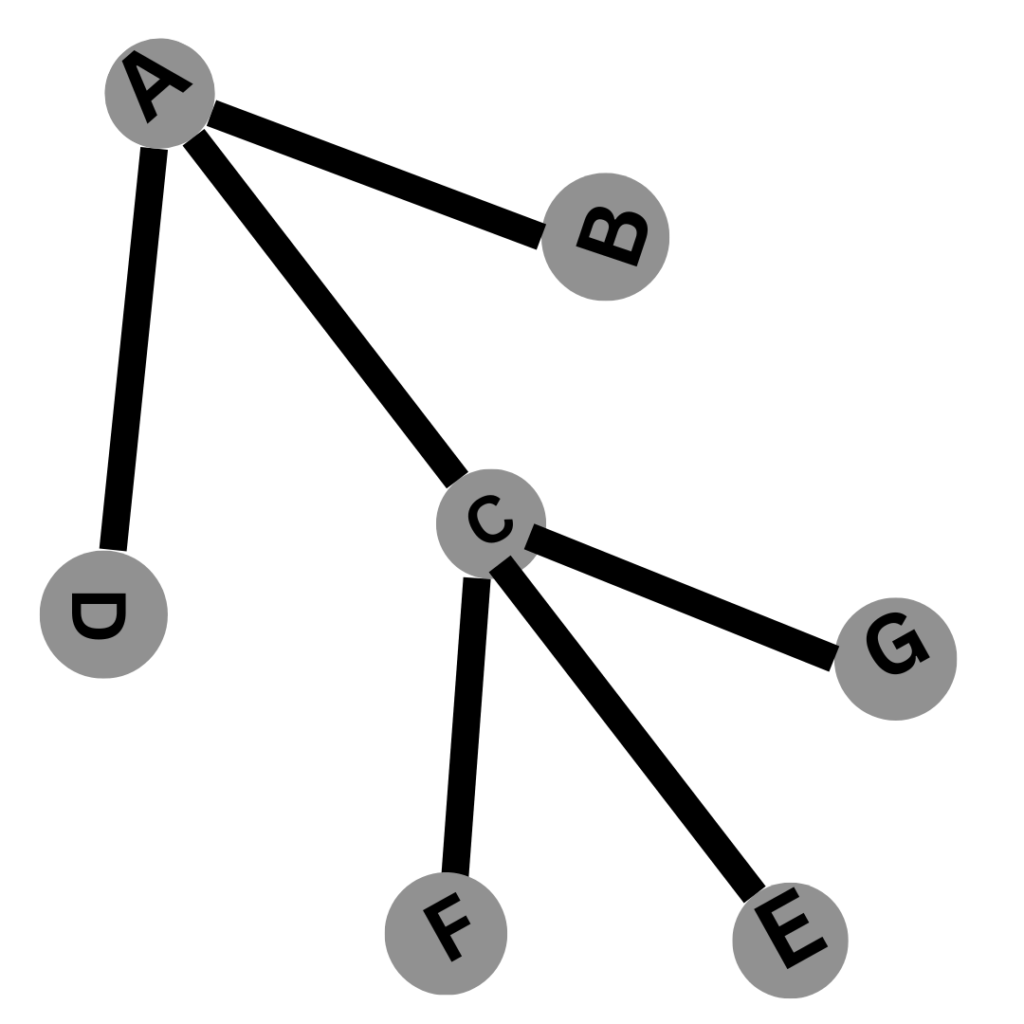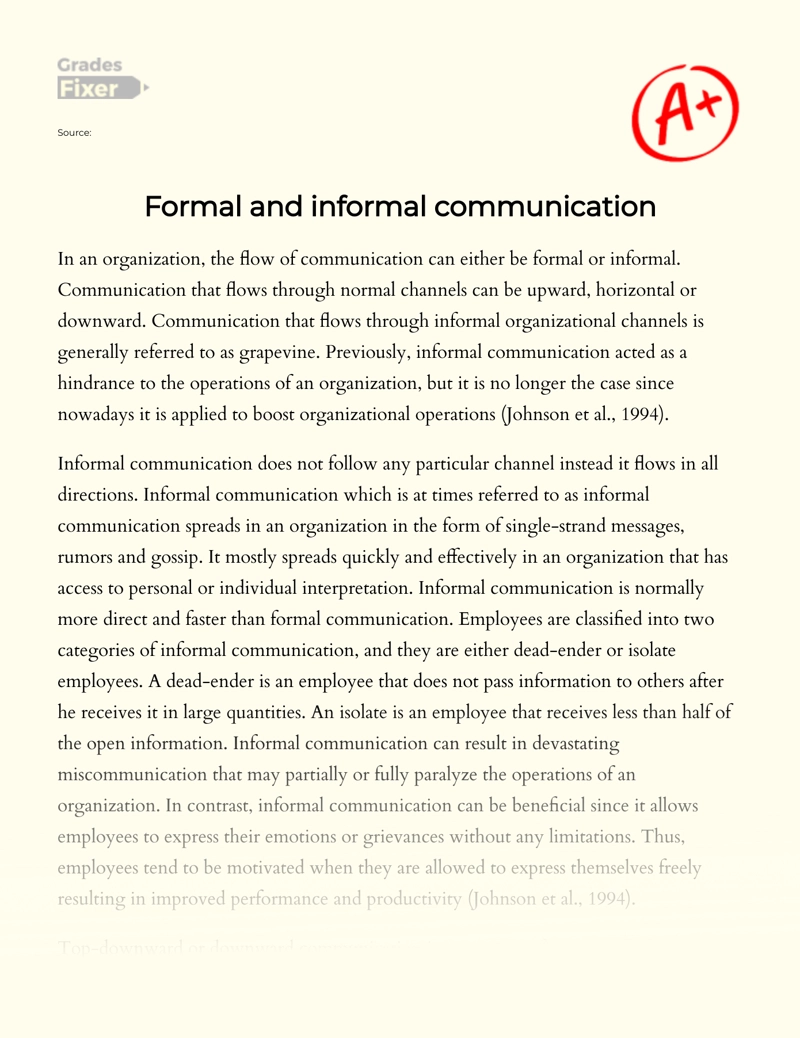

What is Formal and Informal Communication? (Complete Guide)
By Andre Wyatt on January 27, 2023 — 13 minutes to read
- Formal & Informal Communication Importance, Purpose, Examples Part 1
- Internal Communications State, Advantages & Disadvantages Part 2
- Challenges of Formal and Informal Communication Part 3
- Informal and Formal Communication Best Practices Part 4
In this article, we will provide comprehensive information on formal and informal communication: definition, difference between formal and informal communication, examples for both types of communication, importance, advantages, disadvantages, challenges, as well as tips and best practices.
What is formal communication?
Formal communication is communication through predefined channels set by organizations. It is backed by organizational procedure, and it is necessary to fulfill the goals of the organization. Formal communication is used in professional and academic settings to provide information and discuss topics in a structured and organized manner. It typically involves the use of more formal language than informal communication, using terms and concepts that are specific to the subject being discussed. Formal communication is often used to convey information in an efficient way. It is also used to maintain a level of professionalism among the participants.
What is informal communication?
Informal communication is more relational than formal. Informal communication is defined as the type of communication that takes place between two or more parties in a casual and unstructured manner, and it is often characterized by the use of informal language. It is not backed by any predetermined channels and can happen anywhere within the organization. Since it is not defined by any channels, messaging moves a lot faster, but it is without any paper trail or official documentation. Informal communication is often used to build relationships and facilitate conversations in social settings, and can be beneficial when developing new ideas or resolving conflicts. The primary goal of this type of communication is to preserve and establish relationships with colleagues. Grapevine communication is a common form of informal communication in a workplace.
Other types of communication in organizations include: Vertical Communication and Horizontal Communication Upward Communication and Downward Communication
Part 1 Why Are Formal and Informal Types of Communication Important?
In its purest form, formal communication is created to increase efficiency within an organization. Predetermined channels of communication are meant to provide a smooth and streamlined method of communication that travels upward and downward . It is the way to easily communicate rules, procedures, and company policy to lower level employees. A formal notification is also favorable in situations where documentation is needed to prove or disapprove a claim or complaint. If someone violated company policy or broke a rule against another coworker, it is easy for employees to point to formal communications between staff and upper management.
Informal communication, as stated above, is all about relationships; if a culture of goodwill and relationship is adequately fostered by the company, then informal discussions can create solidarity and strengthen teams . However, one of the most important reasons for why informal communication is critical to businesses is that it allows employees to give feedback to their superiors. It facilitates the action of upward interface and enables messaging to go both ways efficiently. When employees are given the opportunity to comment on their experiences in the company informally, it puts the ball back in the court of upper management to improve and meet their expectations. This action then leads to higher employee morale.
Also, informal communication can pick up where formal discussions end. A great example of this is conflict resolution. If employees or managers and employees can resolve their problems informally, then this can prevent the need for upper management to have to get involved and elongate the matter.
How does formal communication differ from informal communication?
Formal communication is the exchange of information between two or more individuals in a structured and professional manner. It is often used in the workplace or in any environment where there is a need for clear and organized communication. In contrast, informal communication is more relaxed, open, and casual. It allows for freedom of expression as it does not require the same level of structure and etiquette as formal communication. Both forms of communication are important for different scenarios, depending on the context and the message being conveyed.
When do we use formal communication?
Formal communication is typically used in business and professional settings, such as in emails, presentations, or other written documents. It is also used when communicating with people outside of one’s organization, such as clients and customers. Formal communication can help create a professional image, as well as demonstrate respect for the recipient. It is often characterized by using precise language and avoiding slang or colloquialisms. Formal communication should be written with clarity and conciseness in order to ensure an accurate understanding of the message being conveyed.
When do we use informal communication?
Informal communication is used in many different scenarios, including casual conversations between friends or colleagues. This type of communication is often more relaxed and informal than formal communication, and it does not follow the same strict guidelines that formal communication does. Informal communication gives us the freedom to express ourselves more openly and honestly, without worrying about making mistakes. It can help to build stronger relationships and foster an atmosphere of trust and understanding.
When to use formal or informal communication?
Understanding the difference between formal and informal communication is key. Formal communication should be used in professional settings, such as making a business proposal or submitting a report. In contrast, informal communication is best used in more relaxed settings with friends and colleagues.
What is the purpose of formal communication?
Formal communication is an essential part of any professional setting, as it allows for clear, concise and structured communication between individuals. It is used to convey specific information, such as instructions, policies or procedures and is generally done in a more formalized manner than informal communication. It also provides a sense of order and structure to workplace interactions and helps to maintain a professional atmosphere. Formal communication can take many forms, including written documents, emails, phone calls or face-to-face conversations. When it is used properly, formal communication can be an effective tool for conveying important information in a professional setting.
What are some examples of formal communication?
Examples of formal communication include:
- business emails,
- presentations,
- formal meetings.
What are some examples of informal communication?
Examples of informal communication include conversations between friends and colleagues:
- text messages,
- social media posts,
- phone calls,
- informal face-to-face interactions.
What are some examples of formal communication in different settings?
- In business settings, formal communication can take place in the form of emails, meetings, reports, presentations, memos and other documents.
- In educational contexts, formal communication is often used to explain concepts or provide instruction to students.
- In government settings, formal communication may be used to announce decisions or policies or to communicate between different branches or levels of government.
What is the process of formal communication?
Formal communication generally follows certain protocols in order to ensure clarity and understanding. It requires both the sender and receiver of the message to be aware of the rules, conventions, and expectations of formal communication. Formality can be communicated through the choice of words, tone, body language, and other nonverbal cues.
Properly managed formal communication can help ensure that information is accurately and quickly disseminated throughout the organization. Ineffective formal communication can lead to confusion, inefficiency, and poor decision-making.
Part 2 What Is the State of Modern Internal Communications?
Many factors are impacting the state of internal communication in today’s workplace. Technology is changing the way people want to interact with each other, and it is creating a disruption in the workplace in ways never before seen.
RingCentral, a provider of cloud-based communications and collaboration solutions for businesses, listed some of their findings from a survey about modern communication trends in the workplace.
- 97 percent of their respondents believed that communication impacted tasks on a daily basis.
- 44 percent of respondents want more widespread adoption of internal communication tools.
- When asked about how they would like these tools to evolve in 2015, 17 percent wanted better usage of these tools.
A conversation about formal and informal communication cannot happen without acknowledging the impact of technology. To see how information is funneling from management to employees and from employees to co-workers it would be helpful to gain insight on how email, text messages, and tools like ProsperForms.com have a hand in how these messages are happening. Here are a few other statistics that business leaders should be concerned about concerning formal and informal communications within the company.
- An infographic and survey compiled by ClearCompany revealed that only 14 percent of companies have employees who understand the organization’s strategies, goals, and direction.
- Another stat from that survey showed that only 5.9 percent of companies communicate the organization’s goals every day.
In today’s world, communication is as critical as it ever was. The only problem is that companies might not be utilizing all the tools and procedures at their disposal to better facilitate effective communications from upper management to lower employees, and from employees to their colleagues.
What are formal communication advantages and disadvantages?
- Advantages: formal communication allows for efficient, reliable communication in a controlled manner.
- Disadvantages: lack of flexibility and the potential for misunderstandings due to the lack of personal interaction. Excessive use of formal communication can lead to decrease in creativity as it typically follows a set structure.
What are informal communication advantages and disadvantages?
- Advantages: informal communication can help to build relationships quickly, as people can relate to each other more easily through informal communication.
- Disadvantages: informal communication can lead to misunderstandings and conflict, as the lack of structure can lead to messages being misinterpreted or taken the wrong way. Informal communication can also lead to a lack of consistency and reliability in the workplace, making it difficult for teams to coordinate their efforts effectively.
Part 3 The Challenges of Formal and Informal Communication
Formal communication challenges, acknowledging a new generation, buy-in from employees, inflexibility, contributes to a lack of understanding, slow decision making, informal communication challenges, rumors can spread rapidly, lack of control, an increase in conflict, contradict formal communications, lack of secrecy, part 4 informal and formal communication best practices.
- Foster a Culture of Effective Communications Employees respond well if they feel they can trust that upper management has their best interest at heart. Formal communication does not start when the messages are sent; it begins the second an employee begins their first day. Upper management should reach out to employees in ways that do not always feel rigid and formal to increase their trust and buy-in. This will make it easier for them to accept more essential messages and stay away from potential rumors.
- Streamlined Decision Making Employees can become agitated if a work task depends on formal communication channels of upper management. Leaders can decrease this frustration by better assessing who needs to be involved in the decision-making process and utilizing an approach to get decisions to employees faster.
- Talk About the “Why” Behind the Rules To ensure a safe environment for everyone, there should be established policies for formal and informal communications. However, business leaders should explain why these rules exist and why breaking them can impact the work environment of those around them. The conversation should center on behaviors and how they should align with the mission and vision of the company.
What must be avoided in formal communication situations?
- Poor grammar, spelling, and punctuation must be avoided.
- When engaging in formal communication, it is important to be mindful of the language and tone used.
- Unprofessional language (slang and jargon) should all be avoided as they can create an impression of a lack of professionalism or can result in misunderstandings or awkwardness.
- Unprofessional topics, such as politics or religion are considered inappropriate in formal settings.
- Excessive use of exclamation points or emojis.
- Sarcasm should be avoided in order to prevent any misunderstandings or misinterpretations of the message being communicated.
- It is important to ensure that the language used is respectful and appropriate for the situation.
How to improve written formal communication?
- Take your time to carefully craft the message.
- Make sure that all relevant information is included, and that you are using language that is appropriate for the situation.
- Make sure your message is clear and concise.
- Ask questions to confirm understanding.
- If applicable, consider including examples, diagrams, or charts to help illustrate your point in order to make it easier for your audience to understand.
How to improve formal communications skills?
To improve your ability to communicate formally, practice active listening, use appropriate language, and demonstrate respect for others. Active listening involves paying attention and responding to the speaker’s words with appropriate eye contact, body language, and questions. It is also important to use professional language and avoid slang, as well as being aware of cultural differences and avoiding bias .
- Upward Communication & Downward Communication (Full Guide)
- What is Grapevine Communication? 5 Solutions and Challenges
- 5 Methods of Workspace Communication Improvement
- 7 Actionable Techniques to Improve Internal Communication
- Why Asynchronous Communication Is the Future? Best Practices
- 4 Main Types of Organizational Communication [Pros and Cons]

What is Informal Communication: Examples, Types & Characteristics
Table of Contents
Are you curious about the different ways people communicate in the workplace? While formal communication is essential for conveying official messages, informal communication is also a critical component of effective collaboration and relationship building. In this blog, we’ll dive into what informal communication is, why it matters, and how to make the most of it in your organization. So, let’s get started!
Definition of informal communication
“Informal communication is the transmission of information, ideas, feelings, and attitudes through channels that are not officially recognized by the organization or institution, but are instead based on personal relationships, common interests, and social networks.” – Chester Barnard, in his book “The Functions of the Executive” (1938). Barnard was an American business executive and author .
What is informal communication?
Informal communication is a mode of exchanging information, ideas, and opinions in an informal and unstructured way between individuals. It occurs outside of formal channels or official hierarchies and often takes place among peers, or colleagues who have a personal relationship or shared interests.
Informal communication can take many forms, including casual conversations, gossip, small talk, social media interactions, and even nonverbal cues such as body language and facial expressions.
What is informal communication in the workplace?
Informal communication in the workplace is a way for coworkers to communicate outside of formal channels, such as meetings or emails. It is often spontaneous, and unstructured, and can occur during breaks or social gatherings.
In fact, informal communication networks account for 70 percent of all communication that takes place within an organization. Having this form of communication is crucial in fostering relationships among colleagues, which can ultimately result in improved collaboration and teamwork.
Characteristics of informal communication
Informal communication is a mode of communication that is unstructured and spontaneous, and understanding the characteristics of informal communication can help individuals and organizations to build relationships, share information, and resolve conflicts more effectively.
Some of the characteristics of informal communication are as follows:
1/ Unstructured: Unlike formal communication, which usually follows a specific format and structure, informal communication is unstructured and free-flowing. It can jump from one topic to another without a specific agenda or outline.
2/ Unofficial: Informal communication is typically unofficial and not authorized by the organization. It is often not documented or recorded, and may not follow official policies or guidelines.
3/ Multidirectional: Informal communication can flow in all directions, between colleagues, managers, subordinates, or even across departments. It is not limited to hierarchical structures or formal reporting lines.
4/ Often nonverbal: Informal communication can also take the form of nonverbal communication such as body language, facial expressions, or gestures. These nonverbal cues can convey meaning and emotion in a way that words alone cannot.
5/ Flexible: Informal communication is more flexible than formal communication. It allows individuals to adapt their communication style to the context and the audience.
6/ Casual tone: Informal communication often has a casual and relaxed tone, without the use of formal language or rigid protocols. People may use humor or informal expressions that are not typically used in formal communication.
7/ Spontaneous: Informal communication is often spontaneous and occurs in real-time.
Types of informal communication
There are several types of informal communication that can take place in the workplace, and understanding these different types can help individuals navigate their interactions more effectively. Let’s take a closer look at the four common types of informal communication:
1/ Single Strand: In a single-strand communication pattern, information is passed from one person to another in a linear sequence, like a chain.

For example, if one employee hears a rumor about a change in company policy, they may pass it on to the next employee, who then passes it on to another employee, and so on. This type of communication can be relatively slow and may result in inaccurate information.
2/ Gossip Chain: A gossip chain occurs when information is passed from one person to another in a non-linear pattern, typically through gossip or rumors.

This type of communication can be very fast and can spread widely throughout an organization, but it can also be unreliable and may result in the spread of false or harmful information.
3/ Probability Chain: In a probability chain communication pattern, information is passed from one person to another based on the likelihood of that person being interested or affected by the information.

For example, if an employee hears about a new project that is relevant to their department, they may pass the information on to other employees who are also likely to be interested in the project. This type of communication can be more efficient than single-strand communication, but it can also result in information being restricted to certain groups.
4/ Cluster Chain: A cluster chain occurs when information is passed within a group of closely connected individuals, such as a team or department. This type of communication can be very effective for sharing information and building relationships within a group, but it can also lead to groupthink or a lack of diversity of ideas.

It’s important to note that while informal communication can be valuable in many ways, it should not replace formal communication channels entirely.
-Extra Learnings What are the types of informal systems? Grapevine system: This is a type of informal communication system where rumors and gossip spread through a network of employees. Social systems: These informal systems are based on social relationships and networks that develop within an organization. Communication systems: These informal systems refer to the informal channels of communication that develop within an organization, such as the grapevine or informal networks. Cultural systems: These informal systems refer to the shared values, beliefs, and assumptions that exist within an organization.
Examples of informal communication in the workplace
1/ Lunchtime conversations: Lunch breaks are a great opportunity for colleagues to socialize and chat about non-work-related topics. 2/ Office events: Workplace events like holiday parties, team-building activities or happy hours provide opportunities for colleagues to get to know each other on a personal level and engage in informal communication. 3/ After-work drinks: Going out for drinks after work is a common way for colleagues to unwind and socialize outside of the office. This can be a great opportunity to build relationships and get to know your colleagues on a more personal level.
Examples of informal language
Informal: I don’t think the results are accurate. Formal: The accuracy of the results is in doubt. Informal: The research project won’t continue next year. Formal: The research project will not be continued in the forthcoming year. ( Source)
Examples of informal groups in organizations
Peer groups are one of the most common informal groups within organizations.
Peer groups: Informal groups may also form based on similarities in job roles or levels within the organization, such as a group of junior employees who meet regularly to discuss their experiences and share advice on navigating the workplace.
Examples of informal sentences
“I’m thinking of calling in sick tomorrow, I could really use a break.” “Hey, have you heard about the new project that’s coming up?” “I’m swamped with work this week, can we catch up later?”
Role of Informal Communication in an Organization
The role of informal communication in an organization is significant. Informal communication allows employees to interact on a more personal level, building relationships and creating a sense of community within the organization.
It also allows for the sharing of information and ideas that might not be communicated through formal channels. Informal communication can be a valuable tool for resolving conflicts and boosting morale, as it provides an outlet for employees to express their thoughts and feelings in a non-threatening environment.
It can also aid in networking and building professional connections. Overall, informal communication plays an important role in promoting collaboration, fostering innovation, and enhancing the overall performance of the organization.
Importance of informal communication
Informal communication can also be beneficial as it can promote open communication, build relationships, and foster a positive work environment. In this context, let’s take a look at the importance of informal communication:
- Building relationships: Informal communication allows people to connect on a personal level and build relationships based on trust and mutual understanding.
- Providing feedback: Informal communication can provide an opportunity for individuals to give and receive feedback on work-related issues in a more relaxed and comfortable setting. This can help to improve performance and productivity.
- Sharing information: Informal communication can be a way for people to share information that may not be appropriate or necessary to share through formal channels.
- Strengthening company culture: By encouraging open communication, transparency, and inclusivity, informal communication can contribute to the development of a positive company culture.
However, it’s important to strike a balance between informal and formal communication to ensure that important information is not missed or misunderstood.
Difference between formal and informal communication
To know more check out our detailed article on : Difference between formal and informal channels of communication
Difference between formal and informal letters
Check out our detailed article on: Formal vs informal letters with examples
Differences between formal and informal meetings
Formal and informal conversation, strategies for balancing formal and informal communication.
Both formal and informal communication channels have their own strengths and weaknesses, and finding the right balance between them can be critical for success. In this section, we will discuss some strategies that can help you navigate the trade-offs between formal and informal communication and make the most of both approaches.
1/ Establish clear communication channels: Make sure there are clear and effective channels for both formal and informal communication. This may involve conducting frequent team meetings, scheduling one-on-one check-ins, implementing an open-door policy, and utilizing online collaboration tools.
2/ Train employees on communication skills: Provide training and development opportunities to help employees develop effective business communication and soft skills , including listening, speaking, and writing. This can help employees feel more confident communicating both formally and informally.
3/ Use business communication tools: The utilization of business communication software such as instant messaging platforms can simplify communication processes and decrease reliance on informal channels.
4/ Monitor informal communication channels: Monitoring informal communication channels, such as the grapevine or social media, can help managers identify potential problems early and take action to address them before they become bigger issues.
5/ Recognize the value of informal communication: Recognize that informal communication can have positive benefits, such as building relationships and fostering creativity. Encourage positive informal communication, while keeping an eye out for any negative effects.
Ways to make informal communication effective
Effective informal communication is crucial for building strong relationships, whether in personal or professional settings. Here are some tips to make informal communication more effective:
(A) Keep it Relaxed:
- Informal communication should be relaxed and unforced. Avoid excessive formality.
- Use a conversational tone and be yourself, so the other person feels comfortable.
(B) Factor Timing into Your Approach:
- Choose an appropriate time for informal conversations. Don’t initiate deep or sensitive topics when the other person is stressed or busy.
- Be respectful of their schedule and availability.
(C) Share Personal Stories:
- Sharing personal stories can make conversations more relatable and engaging. It also helps establish a deeper connection with the other person.
- Choose stories that are relevant to the topic and add value to the conversation.
(D) Follow Up:
- Informal communication is not just about the current conversation. Follow up with the other person to show that you value the relationship.
- Check-in on how they are doing or continue discussions from previous conversations.
(E) Be Respectful:
- Respect the other person’s boundaries and privacy. Avoid asking overly personal questions if it makes them uncomfortable.
- Respect differences in opinions, values, and beliefs.
By practicing these tips, you can enhance your ability to connect with others on a personal level and build lasting bonds.
Advantages and disadvantages of informal communication
Advantages of informal communication.
- Greater employee empowerment: When employees feel comfortable sharing their thoughts and opinions, they may feel more empowered to make decisions and take ownership of their work.
- Enhances decision-making: Informal communication can provide valuable feedback and insights that can be used to make better decisions. This can lead to better outcomes and a more successful organization.
- Improved feedback: In a more informal setting, employees may be more comfortable providing feedback to their managers and colleagues. This can lead to more constructive criticism and a better understanding of areas for improvement.
Disadvantages of informal communication
- Lack of control: Informal communication channels can be difficult to control, and it can be challenging to ensure that the right people are receiving the right information.
- May not be suitable for all situations: Informal communication may not be appropriate for all situations, such as when communicating sensitive or confidential information.
- Lack of structure: Informal communication can lack structure, which may make it difficult to ensure that important information is shared and understood by all parties involved.
Further Reading: What are the advantages and disadvantages of informal communication
What is grapevine communication?
Grapevine communication refers to an unofficial and informal communication system that operates within an organization. The grapevine can be described as the gossip, and rumors that circulate among employees in an organization.
This type of communication is often used to satisfy employees’ social needs and can sometimes provide valuable information to management about employee morale, opinions, and concerns. However, because grapevine communication is informal, the information exchanged can often be inaccurate or incomplete, leading to misunderstandings and misinterpretations.
Further Reading: What is grapevine communication with types and examples
What is called formal communication?
Formal communication is an official type of communication that takes place within a business or organization and is typically structured and intentional.
It is usually carried out through pre-determined channels of communication, such as memos, reports, official letters, and meetings, and follows a specific chain of command. Formal communication benefits larger organizations where there are multiple levels of management and many employees.
Further Reading: Formal communication definition and examples
Frequently Asked Questions
Q1) what is informal communication and examples .
Ans: Informal communication refers to the transmission of information through casual or unofficial channels, rather than through official or structured channels. Examples include gossip, rumors, social media interactions, and personal conversations.

Q2) What are formal and informal communication?
Ans: Formal communication refers to official communication that follows prescribed rules, protocols, and hierarchical structures within an organization. On the other hand, informal communication refers to communication that takes place outside the official channels of an organization, such as casual conversations or chats among coworkers.
Q3) What are the types of informal communication?
Ans: The four types of informal communication networks include Single Strand, Gossip Chain, Probability Chain, and Cluster Chain. Understanding these different types of informal communication networks can help you to better navigate and leverage them for the benefit of your organization.
Q4) What is Informal communication in English?
Ans: Informal communication in English refers to the use of casual language in everyday interactions, rather than formal or academic language. This type of communication often includes idioms and other informal expressions.
Q5) What is informal information?
Ans: Informal information refers to knowledge or data that is transmitted through informal communication channels, rather than through formal or structured channels.
Q6) What is informal communication in business communication?
Share your read share this content.
- Opens in a new window
Aditya Soni
You might also like.

Physiological Barriers To Communication: Examples & How to Overcome

What is Face-to-Face Communication: Examples, Types & Importance

Barriers To Effective Communication With Examples & Types
Leave a reply cancel reply.
Save my name, email, and website in this browser for the next time I comment.
Would you like to view this website in another language?
Informal Communication: The Powerhouse in Workplaces
- Written by: Rinaily Bonifacio
- Last updated: 4 March 2024

This article will explore the significance of informal communication methods in the workplace, its various types, and how it can benefit businesses.
Table of contents
What is informal communication in the workplace?
Types of informal communication, how can informal communication benefit a business, examples of informal communication in the workplace, what is the purpose of formal communication, difference between formal and informal communication, when to use formal or informal communication, false rumours: addressing misinformation in the workplace, what are some examples of formal communication, does informal communication have any benefits, what is the process of formal communication, striking a balance: tips to use formal and informal communication in the workplace.
Informal communication refers to the casual and spontaneous exchange of information, ideas, and emotions among employees outside the boundaries of formal channels. It occurs naturally through interactions, conversations, and organizational social relations.
Unlike formal communication, which follows predefined channels and established protocols, informal communication is more flexible, fluid, and personal.
It often occurs during lunch breaks, coffee chats, or water cooler moments, creating an informal grapevine that interconnects individuals across various hierarchical levels and departments.
Informal communications manifests in several forms, each serving a unique purpose within the workplace. Let's explore some common types:
Informal conversations
These impromptu exchanges occur throughout the workday and can cover various topics, from weekend plans to shared interests. They foster camaraderie, build relationships, and create a sense of belonging among employees.
Instant messaging
With the advent of digital communication tools, informal conversations have moved into the virtual realm. Platforms like Slack and Microsoft Teams facilitate quick chats, allowing employees to communicate in real-time, irrespective of their physical proximity.
Verbal communication
Face-to-face conversations, whether in a formal meeting room or during a chance encounter in the hallway, offer spontaneous discussions, clarification of doubts, and brainstorming sessions. They allow for richer exchanges by incorporating nuances of body language and tone of voice.
Social interactions
Informal communication also extends beyond work-related matters. Social gatherings, team-building activities , or even watercooler discussions create personal spaces for employees to connect, fostering stronger relationships and a sense of community.

Informal communication offers businesses several benefits, regardless of size or industry. Let's explore some of the key advantages:
Increased employee morale
When employees feel comfortable engaging in informal communication, it creates a positive work environment that fosters camaraderie and boosts employee morale . This, in turn, leads to higher job satisfaction and increased retention rates .
Enhanced collaboration and teamwork
Informal communication allows employees to connect with colleagues from different departments or organizational levels. This cross-pollination of ideas and perspectives promotes collaboration, breaks down silos, and drives innovation within the organization.
Improved feedback and performance management
Informal communication channels provide a more informal and relaxed atmosphere for feedback exchange. Employees can offer constructive criticism, share suggestions for improvement, and receive real-time guidance, fostering continuous learning and growth.
Faster issue resolution
Informal communication enables prompt issue identification and resolution. By encouraging employees to openly discuss challenges, conflicts, or concerns, organizations can address issues before they escalate, leading to a more harmonious and productive work environment.
To illustrate the practical applications of informal communication, let's explore a few examples:
Watercooler conversations
Employees gather around the office water cooler, discussing the latest industry news, sharing personal anecdotes, or exchanging tips and tricks for work-related challenges. These informal conversations foster connections and build a sense of community within the workplace.
Digital coffee chats
With the rise of remote work and digital collaboration tools, virtual coffee chats have become a popular way to replicate informal office interactions. Employees can join a virtual meeting room for casual conversations, providing an avenue for relationship-building, even when physically distant.
Team-building activities
Whether it's a company retreat, a team lunch, or an after-work social event, team-building activities create opportunities for employees to bond outside the formal work environment. These events promote camaraderie, boost employee morale, and foster a sense of belonging.

Formal communication serves several essential purposes in the workplace:
Conveying official information
Formal communication methods, such as official documents, memos, and company-wide emails, are instrumental in disseminating official information, policies, and procedures. They ensure that all employees receive consistent and accurate messages from the organization.
Establishing clear expectations
Formal communication provides a platform for management to communicate expectations, goals, and performance metrics to employees. It sets clear guidelines and enables employees to align their efforts with organizational objectives.
Promoting compliance and accountability
Formal communication is crucial in conveying legal and regulatory requirements to employees. It ensures everyone knows their responsibilities and complies with applicable laws and regulations.
Documenting business transactions
Formal communication facilitates the documentation of important business transactions, such as contracts, agreements, and performance evaluations. It creates a paper trail that can be referred to in case of disputes or legal requirements.
Formal and informal communication differ, including their characteristics, channels, and purpose. Let's explore some key differences:
Characteristics of formal communication:
- Structured and predefined
- Follows established protocols and procedures
- Official and documented
- Conveys official information and directives
- Hierarchical and top-down flow
Characteristics of informal communication:
- Casual and spontaneous
- Flexible and adaptable
- Personal and interpersonal
- Facilitates social interactions and relationship-building
- Bi-directional and multidirectional flow
While formal communication ensures the efficient transmission of official messages, policies, and procedures, informal communication adds depth and richness to interpersonal relationships and contributes to a positive work environment.

Choosing between formal and informal communication depends on the nature of the message, the desired outcome, and the organizational context. Here are some guidelines to help you determine when to use each type:
When to use formal communication:
- Conveying official policies, procedures, and announcements
- Sharing critical and sensitive information
- Documenting agreements, contracts, or legal matters
- Addressing large groups or disseminating information to a wide audience
- Communicating performance expectations and evaluations
When to use informal communication:
- Seeking immediate feedback or input on non-sensitive matters
- Building relationships and rapport with colleagues
- Brainstorming ideas or engaging in creative discussions
- Providing coaching or mentoring
- Sharing non-official information, such as industry news or personal anecdotes
By understanding the appropriate contexts for each type of communication, organizations can ensure effective information flow and maximize the benefits of both formal and informal channels.
One of the potential downsides of informal communication is the spread of false rumours.
In a fast-paced and interconnected workplace, rumours can quickly propagate through informal channels, causing anxiety, eroding trust, and disrupting productivity.
Organizations should prioritize clear and transparent formal communication to address false rumours effectively.
By providing accurate and timely information through official channels, management can mitigate the impact of false rumours, maintain trust among employees, and foster a culture of open and honest communication .

Formal communication takes various forms in the workplace. Here are some examples:
- Official memos or announcements
- Company-wide emails
- Performance evaluations and feedback sessions
- Team or department meetings
- Presentations or training sessions conducted by management
These examples demonstrate how formal communications convey official information, clarify expectations, and facilitate structured organizational interactions.
Absolutely! Informal communication offers numerous benefits to organizations. Some of the key advantages include:
- Enhanced employee engagement and job satisfaction
- Improved collaboration and innovation
- Increased knowledge-sharing and learning opportunities
- Faster issue identification and resolution
- Strengthened relationships and a sense of belonging
By harnessing the power of informal communication, organizations can create a positive work environment that fosters employee well-being , productivity , and long-term success.
Formal communication follows a structured process to ensure the effective transmission of information. The process typically involves the following steps:
Message Creation: The sender formulates the message, considering its purpose, content, and intended audience.
Message Encoding: The sender converts the message into a suitable format, such as a memo, email, or presentation, ensuring clarity and accuracy.
Message Transmission: The sender delivers the message through formal channels, such as official documents, meetings, or designated communication platforms.
Message Reception: The intended recipients receive the message through the established channels and acknowledge its receipt if required.
Message Decoding: The recipients interpret and understand the message by extracting its meaning and context.
Feedback and Response: The recipients may provide feedback, seek clarification, or take appropriate actions based on the received message.
By following this process, organizations can ensure the effective flow of formal communication, promoting clarity, understanding, and alignment.

To leverage the benefits of both formal and informal communication, organizations can follow these tips:
Encourage open dialogue
Create a culture that values open dialogue and active participation. Encourage employees to share ideas, concerns, and feedback through formal and informal channels.
Foster strong relationships
Promote opportunities for employees to connect on a personal level. Encourage team-building activities, social events, and informal interactions to build stronger colleague relationships.
Provide communication training
Offer communication skills training to employees, emphasizing the importance of formal and informal communication. Equip them with the skills to navigate different communication scenarios effectively.
Promote clarity and transparency
Ensure that formal communication channels provide clear and accurate information. Transparent and timely communication reduces the reliance on informal channels for rumours or misinformation.
Lead by example
Managers and leaders should model effective communication behaviours, embracing formal and informal interactions. They should actively engage in open dialogue, provide regular feedback, and encourage informal conversations.
By implementing these tips, organizations can strike a balance between formal and informal communication, creating a dynamic and inclusive workplace environment.
.png?width=323&height=124&name=img-16%20(1).png)
Employee scheduling and Time-tracking software!
- Easy Employee scheduling
- Clear time-tracking
- Simple absence management
Informal communication is critical in building connections, enhancing workplace dynamics, and nurturing a positive work environment. By recognizing the importance of informal communication and harnessing its potential, employers, HR professionals, and small business owners can create thriving workplaces that promote employee engagement, collaboration, and innovation.
Enhancing informal communication with Shiftbase
In the context of growing workplace fluidity, fostering effective informal communication channels is key. This is where Shiftbase comes in. Our innovative SaaS tool can be a catalyst for enhancing informal communication in your organization. Beyond employee scheduling , time tracking , and absence management , Shiftbase promotes a platform for instantaneous interaction and information sharing, fostering a sense of unity and collaboration among team members. To witness a direct positive impact on your workforce dynamics, why not take a step forward? Try Shiftbase free for 14 days and experience a more harmonized, effective, and communicative work environment.
Written by:
Rinaily Bonifacio
Rinaily is a renowned expert in the field of human resources with years of industry experience. With a passion for writing high-quality HR content, Rinaily brings a unique perspective to the challenges and opportunities of the modern workplace. As an experienced HR professional and content writer, She has contributed to leading publications in the field of HR.
Please note that the information on our website is intended for general informational purposes and not as binding advice. The information on our website cannot be considered a substitute for legal and binding advice for any specific situation. While we strive to provide up-to-date and accurate information, we do not guarantee the accuracy, completeness and timeliness of the information on our website for any purpose. We are not liable for any damage or loss arising from the use of the information on our website.
Ready to try Shiftbase for free?
- 360 Feedback
- Probation Review Meeting
- Communication Styles
- Types of Feedback
- Constructive Criticism

To read this content please select one of the options below:
Please note you do not have access to teaching notes, informal communication in organizations: work time wasted at the water-cooler or crucial exchange among co-workers.
Corporate Communications: An International Journal
ISSN : 1356-3289
Article publication date: 20 January 2022
Issue publication date: 30 June 2022
Previous research assumes that informal communication may be highly relevant for organizations, but little is known about its actual relevance for employees or its functions and effects. The article aims to examine functions, types and effects of informal communication in organizations.
Design/methodology/approach
Research on internal communication usually focuses on formal strategic communication with or among employees. Informal communication between employees in organizations has received far less attention, although a great deal of communication in organizations is informal. Therefore, the present study analyses informal communication in organizations. The authors conducted a quantitative online survey of employees working for different organizations in Germany.
The authors show that five types of employee can be differentiated regarding their informal communication behavior: the chatterer, the focuser, the strategist, the small-talker and the networker. Moreover, the study demonstrates that informal communication significantly increases employees' perceptions of being informed, as well as their affective commitment, both of which increase job satisfaction. Finally, results show that informal communication does not decrease employees' productivity, but instead helps them to carry out their jobs more effectively.
Originality/value
Although previous studies indicate that a large part of the communication among employees within an organization is informal, research has rarely dealt with this phenomenon, instead focusing especially on formal communication. This is one of the first papers that focuses on informal communication among employees using quantitative survey data.
- Informal communication
- Internal communication
- Communication functions
- Productivity
Koch, T. and Denner, N. (2022), "Informal communication in organizations: work time wasted at the water-cooler or crucial exchange among co-workers?", Corporate Communications: An International Journal , Vol. 27 No. 3, pp. 494-508. https://doi.org/10.1108/CCIJ-08-2021-0087
Emerald Publishing Limited
Copyright © 2021, Emerald Publishing Limited
Related articles
We’re listening — tell us what you think, something didn’t work….
Report bugs here
All feedback is valuable
Please share your general feedback
Join us on our journey
Platform update page.
Visit emeraldpublishing.com/platformupdate to discover the latest news and updates
Questions & More Information
Answers to the most commonly asked questions here
Home — Essay Samples — Sociology — Effective Communication — Formal and Informal Communication in Organization
Formal and Informal Communication in Organization
- Categories: Communication Skills Effective Communication
About this sample

Words: 380 |
Published: Jul 17, 2018
Words: 380 | Page: 1 | 2 min read

Cite this Essay
Let us write you an essay from scratch
- 450+ experts on 30 subjects ready to help
- Custom essay delivered in as few as 3 hours
Get high-quality help

Dr Jacklynne
Verified writer
- Expert in: Life Sociology

+ 120 experts online
By clicking “Check Writers’ Offers”, you agree to our terms of service and privacy policy . We’ll occasionally send you promo and account related email
No need to pay just yet!
Related Essays
2 pages / 879 words
1 pages / 439 words
2 pages / 878 words
2 pages / 702 words
Remember! This is just a sample.
You can get your custom paper by one of our expert writers.
121 writers online

Still can’t find what you need?
Browse our vast selection of original essay samples, each expertly formatted and styled
Related Essays on Effective Communication
Direct persuasion is a form of communication that aims to influence an individual or a group's beliefs, attitudes, opinions, or behaviors. Direct persuasion can be delivered through various communication channels, such as [...]
Effective communication is the lifeblood of any successful organization. In the dynamic and interconnected world of business, the ability to convey ideas, information, and messages with clarity and precision is crucial. Business [...]
Effective communication within the healthcare setting is crucial for providing quality care to patients. It involves not only the interaction between patients and physicians, but also includes other individuals within the [...]
In Nursing, communication is crucial in that it facilitates the improvement of outcomes, fosters relationships, and helps in facilitating effective teamwork. When carrying out nursing activities, information is needed from the [...]
Communication is the strongest medium through which we can either build our connections with people or ruin it by creating misunderstandings. Hence to make our communication more effective we should make sure that we reduce [...]
Effective communication involves effective speaking and active listening. Verbal exchanges in discussions are not sufficient in relaying messages. Other factors such as tonal variations and non-verbal cues are also crucial. [...]
Related Topics
By clicking “Send”, you agree to our Terms of service and Privacy statement . We will occasionally send you account related emails.
Where do you want us to send this sample?
By clicking “Continue”, you agree to our terms of service and privacy policy.
Be careful. This essay is not unique
This essay was donated by a student and is likely to have been used and submitted before
Download this Sample
Free samples may contain mistakes and not unique parts
Sorry, we could not paraphrase this essay. Our professional writers can rewrite it and get you a unique paper.
Please check your inbox.
We can write you a custom essay that will follow your exact instructions and meet the deadlines. Let's fix your grades together!
Get Your Personalized Essay in 3 Hours or Less!
We use cookies to personalyze your web-site experience. By continuing we’ll assume you board with our cookie policy .
- Instructions Followed To The Letter
- Deadlines Met At Every Stage
- Unique And Plagiarism Free

Extended Essay: Formal vs. Informal Writing
- Extended Essay- The Basics
- Step 1. Choose a Subject
- Step 2. Educate yourself!
- Using Brainstorming and Mind Maps
- Identify Keywords
- Do Background Reading
- Define Your Topic
- Conduct Research in a Specific Discipline
- Step 5. Draft a Research Question
- Step 6. Create a Timeline
- Find Articles
- Find Primary Sources
- Get Help from Experts
- Search Engines, Repositories, & Directories
- Databases and Websites by Subject Area
- Create an Annotated Bibliography
- Advice (and Warnings) from the IB
- Chicago Citation Syle
- MLA Works Cited & In-Text Citations
- Step 9. Set Deadlines for Yourself
- Step 10. Plan a structure for your essay
- Evaluate & Select: the CRAAP Test
- Conducting Secondary Research
- Conducting Primary Research
- Formal vs. Informal Writing
- Presentation Requirements
- Evaluating Your Work
Differences Between Informal and Formal Essays
When writing your extended essay you should use language that is formal and academic in tone. The chart below gives you some idea of the differences between informal and formal essays. See the box below for examples of the differences in tone in informal and formal essays written on identical topics. A PDF of this chart, and the examples below, is in the box to the right , along with a list of tips for avoiding colloquial writing.
Examples of Informal and Formal Tone in Essay Writing
The following examples highlight the differences between formal and informal tone.
Language B - English
- Formal vs. Informal Writing A chart giving the differences between informal and formal essays in seven areas (author's viewpoint; subject/content (sources of evidence); tone; structure; location of the research question; vocabulary; and purpose. Also included are examples comparing informal and formal writing for essays in English, biology, and psychology.
- How to Avoid Colloquial (Informal) Writing While it may be acceptable in friendly e-mails and chat rooms, excessive colloquialism is a major pitfall that lowers the quality of formal written text. Here are some steps/tips that you can follow to help improve your overall writing.
- << Previous: Plagiarism
- Next: Presentation Requirements >>
- Last Updated: Feb 2, 2024 1:39 PM
- URL: https://libguides.westsoundacademy.org/ee

IMAGES
VIDEO
COMMENTS
Formal communication is the exchange of information between two or more individuals in a structured and professional manner. It is often used in the workplace or in any environment where there is a need for clear and organized communication. In contrast, informal communication is more relaxed, open, and casual.
5/ Flexible: Informal communication is more flexible than formal communication. It allows individuals to adapt their communication style to the context and the audience. 6/ Casual tone: Informal communication often has a casual and relaxed tone, without the use of formal language or rigid protocols. People may use humor or informal expressions ...
Informal Communication Essay. Decent Essays. 941 Words. 4 Pages. Open Document. The use of informal language has become a widespread problem today due to the use of text messaging among one another. Many people engage in conversations and do not even realize that they are using improper grammar majority of the time, along with informal speaking.
Informal communication refers to the casual and spontaneous exchange of information, ideas, and emotions among employees outside the boundaries of formal channels. It occurs naturally through interactions, conversations, and organizational social relations. Unlike formal communication, which follows predefined channels and established protocols ...
The informal communication is the casual and unofficial form of communication. wherein the information is exchanged spontaneously between two or more persons without. conforming the prescribed ...
Conclusion. Informal communication is an exchange of information, either oral or written, that doesn’t fall within the traditional structures, methods, or hierarchies of the business. Examples include casual chats and watercooler catch-ups, as well as office gossip and discussing work in a more relaxed context.
Informal communicattion 2/20/2002 5 Informal communication is a loosely defined concept and is often treated as the residual category in organizational theory. According to this perspective, informal communication is that which remains when rules and hierarchies, as ways of coordinating activities, are eliminated.
Research on internal communication usually focuses on formal strategic communication with or among employees. Informal communication between employees in organizations has received far less attention, although a great deal of communication in organizations is informal. Therefore, the present study analyses informal communication in organizations.
Informal communication which is at times referred to as informal communication spreads in an organization in the form of single-strand messages, rumors and gossip. It mostly spreads quickly and effectively in an organization that has access to personal or individual interpretation. Informal communication is normally more direct and faster than ...
Differences Between Informal and Formal Essays. When writing your extended essay you should use language that is formal and academic in tone. The chart below gives you some idea of the differences between informal and formal essays. See the box below for examples of the differences in tone in informal and formal essays written on identical topics.